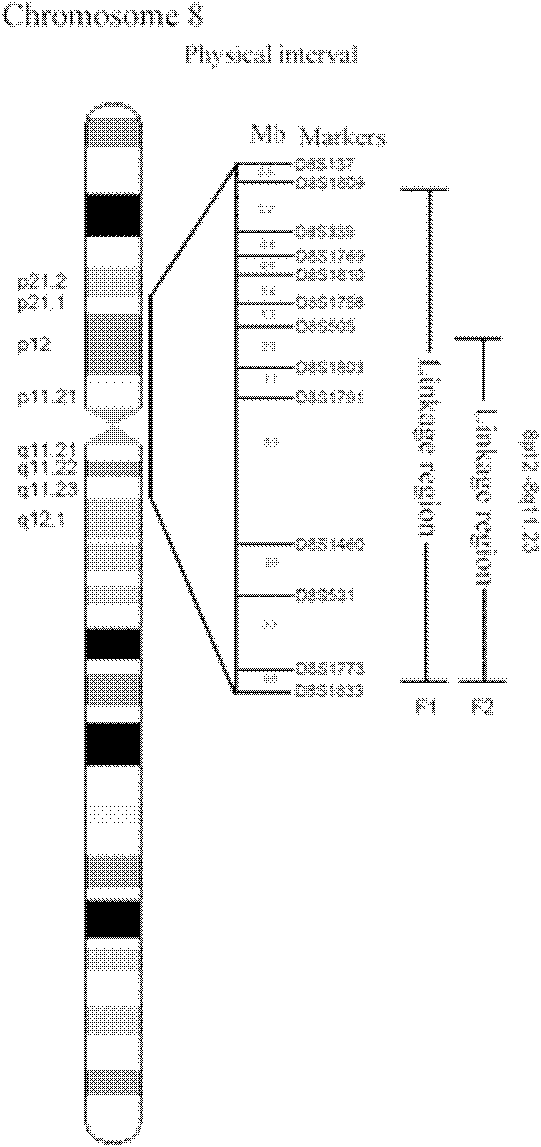Human idiopathic basal ganglia calcification disease-causing gene and coding protein thereof
An idiopathic, human technology applied in the direction of genetic engineering, animal/human peptides, plant genetic improvement, etc., which can solve problems such as loss, dementia of intellectual and conscious performance, impaired motor ability, etc.
- Summary
- Abstract
- Description
- Claims
- Application Information
AI Technical Summary
Problems solved by technology
Method used
Image
Examples
Embodiment 1
[0033] Example 1: Fine Mapping of IBGC3 Pathogenic Sites
[0034] 1. Family collection and identification: The inventor collected the second autosomal dominant IBGC family (8 patients in four generations, the brain CT of the proband as shown in figure 1 , Symmetrical basal ganglia calcium deposits, serum biochemical indicators were normal, in line with the clinical features of IBGC. Pedigree diagram such as figure 2 b) Peripheral blood samples.
[0035] 2. Genomic DNA extraction: Genomic DNA from peripheral blood samples was extracted using the Wizard Genomic DNA Extraction Kit from Promega, USA.
[0036] 3. Linkage analysis of IBGC pathogenic loci: Firstly, linkage analysis of the microsatellite markers in the three reported IBGC locus regions was carried out, and the linkage between the pathogenic genes of this family and IBGC1 and IBGC2 regions was excluded. The pathogenic gene of the second IBGC family was preliminarily located at the IBGC3 locus. For the upstream and...
Embodiment 2
[0038] Embodiment 2: Cloning of IBGC pathogenic gene
[0039] 1. Screening of candidate genes
[0040] According to the pathological mechanism of basal ganglia calcification and the characteristics of gene structure and function, the inventor preferentially selects genes related to brain expression and nervous system abnormalities as candidate genes. The inventor selects in the mapped IBGC segment (8p12-q11. 41 candidate genes UNC5D, ZNF703, KCNU1, ERLIN2, PROSC, RAB11FIP1, EIF4EBP1, ASH2L, LSM1, BAG4, DDHD2, PPAPDC1B, WHSC1L1, LETM2, ADAM9, ADAM2, ZMAT4, GOLGA7, AGPAT6, NKX6-3, ANK1, PLAT, IKBKB, DKK4, UDAC3, SLC20A2, CHRNB3, CHRNA6, POLB, THAP1, SGK196, HGSNAT, MCM4, EFCAB1, SNAI2, CEBPD, UBE2V2, SNTG1, PXDWL, PCMTD1 and ST18.
[0041] 2. Genomic DNA extraction: Genomic DNA from peripheral blood samples was extracted using the Wizard Genomic DNA Extraction Kit from Promega, USA.
[0042] 3. Sequence the candidate genes
[0043] The inventor uses Primer5 software design (a...
Embodiment 3
[0078] Example 3: Detection of mutations in IBGC pathogenic genes
[0079] In order to verify the mutation of the present invention, we carried out detailed clinical examination on the collected IBGC family members, including brain CT, serum calcium, phosphorus, thyroxine, vitamin D, uric acid, alkaline phosphatase and parathyroid hormone in plasma And other inspections to determine the patients and normal people in the family, and collected 604 cases of normal people outside the family. All family members who participated in the survey and were blood samples were informed about the purpose and significance of this study and gave informed consent.
[0080] 1. Genomic DNA extraction, as described above.
[0081] 2. Detection of SLC20A2 gene mutation by using mismatched primers to create restriction sites
[0082] The inventor found 6 missense mutations and 2 base deletion mutations in the SLC20A2 gene in an autosomal dominant IBGC family, none of which could change the restri...
PUM
| Property | Measurement | Unit |
|---|---|---|
| Absorbance | aaaaa | aaaaa |
Abstract
Description
Claims
Application Information
 Login to View More
Login to View More - R&D
- Intellectual Property
- Life Sciences
- Materials
- Tech Scout
- Unparalleled Data Quality
- Higher Quality Content
- 60% Fewer Hallucinations
Browse by: Latest US Patents, China's latest patents, Technical Efficacy Thesaurus, Application Domain, Technology Topic, Popular Technical Reports.
© 2025 PatSnap. All rights reserved.Legal|Privacy policy|Modern Slavery Act Transparency Statement|Sitemap|About US| Contact US: help@patsnap.com



